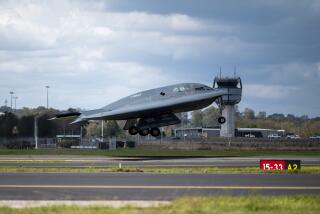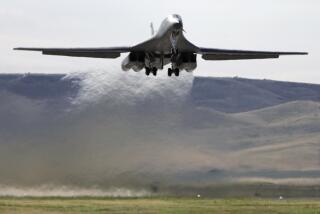Political Radar Picks Up Stealth Bomber
- Share via
Tailed by controversy through much of its existence, the B-2 stealth bomber is flying into a new political cross-fire in California.
With the state’s presidential primary fast approaching, the campaign of Texas Gov. George W. Bush is dropping tantalizing hints that if he is elected, he may order more of the $2.2-billion-a-copy, radar-evading bombers, the most expensive warplane ever built.
Reopening Northrop Grumman Corp.’s assembly line in Pico Rivera would bring billions in revenues and thousands of well-paying jobs to the state.
The Bush campaign’s declarations stand in stark contrast with his rival for the Republican nomination, Sen. John McCain--an outspoken critic of the B-2--and with both of the Democratic contenders, Vice President Al Gore and former Sen. Bill Bradley.
A senior Bush advisor, while cautioning that the candidate would reassess all aircraft programs upon entering office, said the governor views the B-2 as a plane with “a very serious capability” that should be “very much in the picture” in future defense planning.
Citing the warplane’s performance in last year’s Kosovo fighting, the advisor said this attitude toward the plane creates “a 180-degree difference with the McCain campaign.” He said that, given the cost of reopening the assembly line, any buy would have to involve a “double digit” number of airplanes to make economic sense.
A McCain aide shot back that the Bush campaign’s suggestion was “a blatant pander to California, and a very costly one.”
*
Derided for years by critics as a gold-plated boondoggle, the bat-winged bomber won praise during the 78-day Kosovo engagement because of its ability to fly round-trip missions from Whiteman Air Force Base in central Missouri and drop payloads with relatively little risk. With its radar-evading capabilities, the 21-plane B-2 air fleet gives the Air Force the ability to strike anywhere on the globe on one day’s notice, without having to rely on air bases near the target.
Bush stressed the need for the United States to have such capabilities when he laid out his defense program in a speech Sept. 23 in South Carolina.
“In the air, we must be able to strike from across the world with pinpoint accuracy--with long-range aircraft, and perhaps with unmanned systems,” he said.
Clinton administration officials, while praising the plane’s performance in Yugoslavia, have firmly rejected the idea of buying more B-2s, in part because of the expense of restarting production. Though some Air Force officers privately advocate an expansion of the B-2 fleet--and seven former defense secretaries have gone on record for it--the service’s leadership is against the idea.
Among other things, the Air Force brass fears that resuming production of the B-2 would jeopardize its top priority, the F-22 Raptor fighter plane.
McCain supported the B-2 program through the Cold War. But in 1991, as the Soviet Union unraveled, he shifted views, and since then has attacked it as an example of wasteful spending. In this campaign, McCain has called it “unneeded.”
McCain believes the Air Force should keep the planes in service and carry through with planned upgrades, but that it should not invest any more in a plane that was designed to take on the Soviet Union, an aide explained.
Though Gore opposes any expansion of the B-2 program, he supported it during its years of hottest controversy. As a senator in 1990, he voted to keep production going, while Bradley voted against it.
*
The disagreement over the B-2 echoes a fight over the aircraft that was played out during the 1996 election.
In March 1996, Sen. Bob Dole, the Republican presidential nominee, visited Pico Rivera and declared he would add 19 of the bombers. Clinton, whose administration had argued that 20 planes was more than enough, responded by adding one more aircraft, for $493 million.
The B-2 program cost about $44 billion overall, making it the largest defense effort in California history. At its peak, the program involved 40,000 employees in 38 states, and provided more than half of Northrop’s revenues.
The last aircraft was delivered to the Air Force in 1997. Northrop Grumman has since been working on upgrades and improvements, and its work force will continue to help maintain the aircraft.
The program, for years a symbol of California’s defense industry, has been winding down rapidly. Northrop’s Pico Rivera plant is scheduled to close by the end of September.
Yet a company spokesman, Jim Hart, said that if the government wanted to reopen the plant, “it certainly could be done. . . . We do believe the B-2 is a remarkable aircraft.”
At the direction of Congress, the Air Force is studying its needs for new long-range bombers. Under consideration are a slightly upgraded B-2; a somewhat more ambitious redesign resulting in a B-2B, or an altogether different aircraft.
More to Read
Sign up for Essential California
The most important California stories and recommendations in your inbox every morning.
You may occasionally receive promotional content from the Los Angeles Times.











